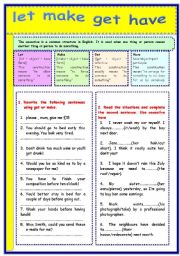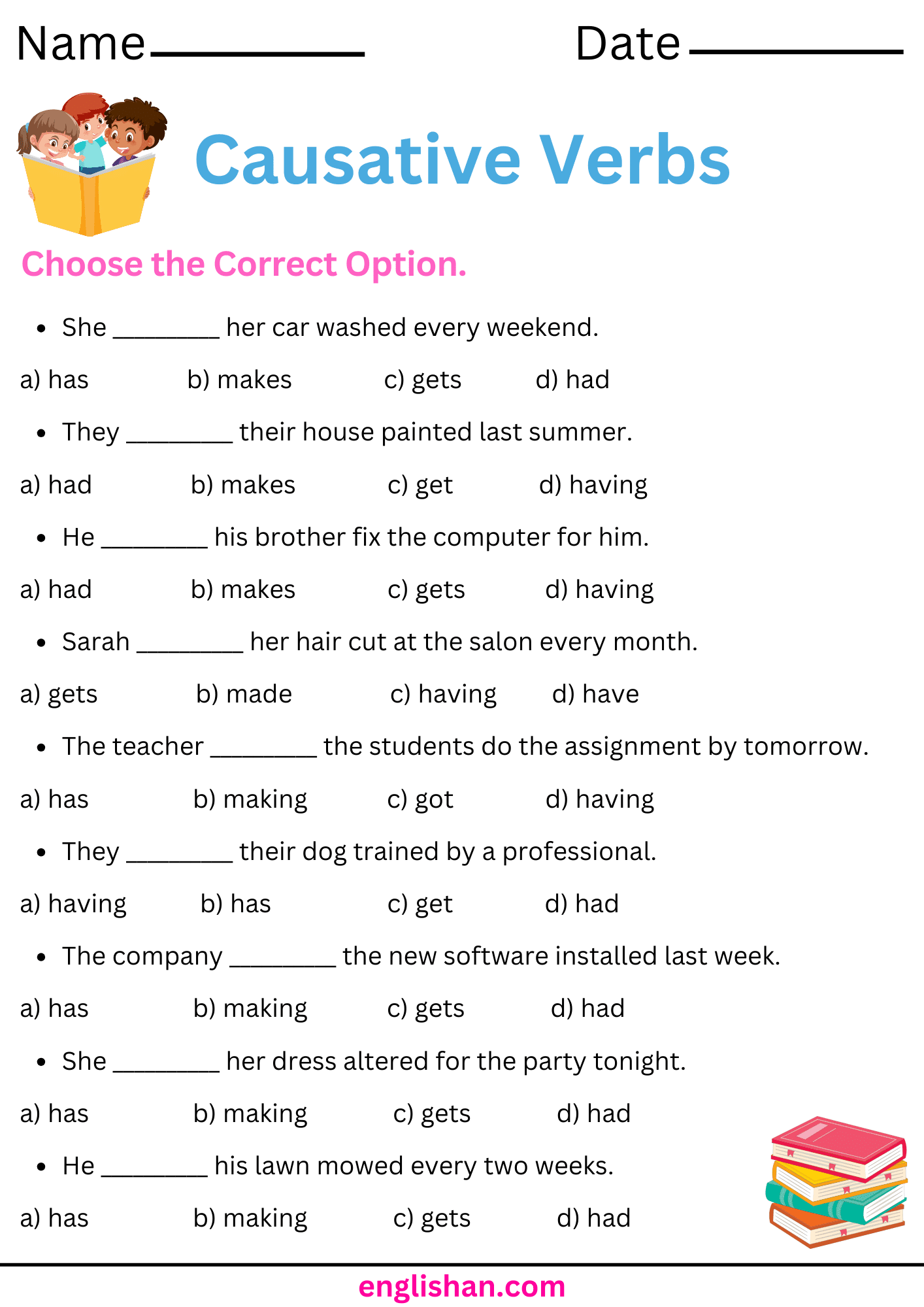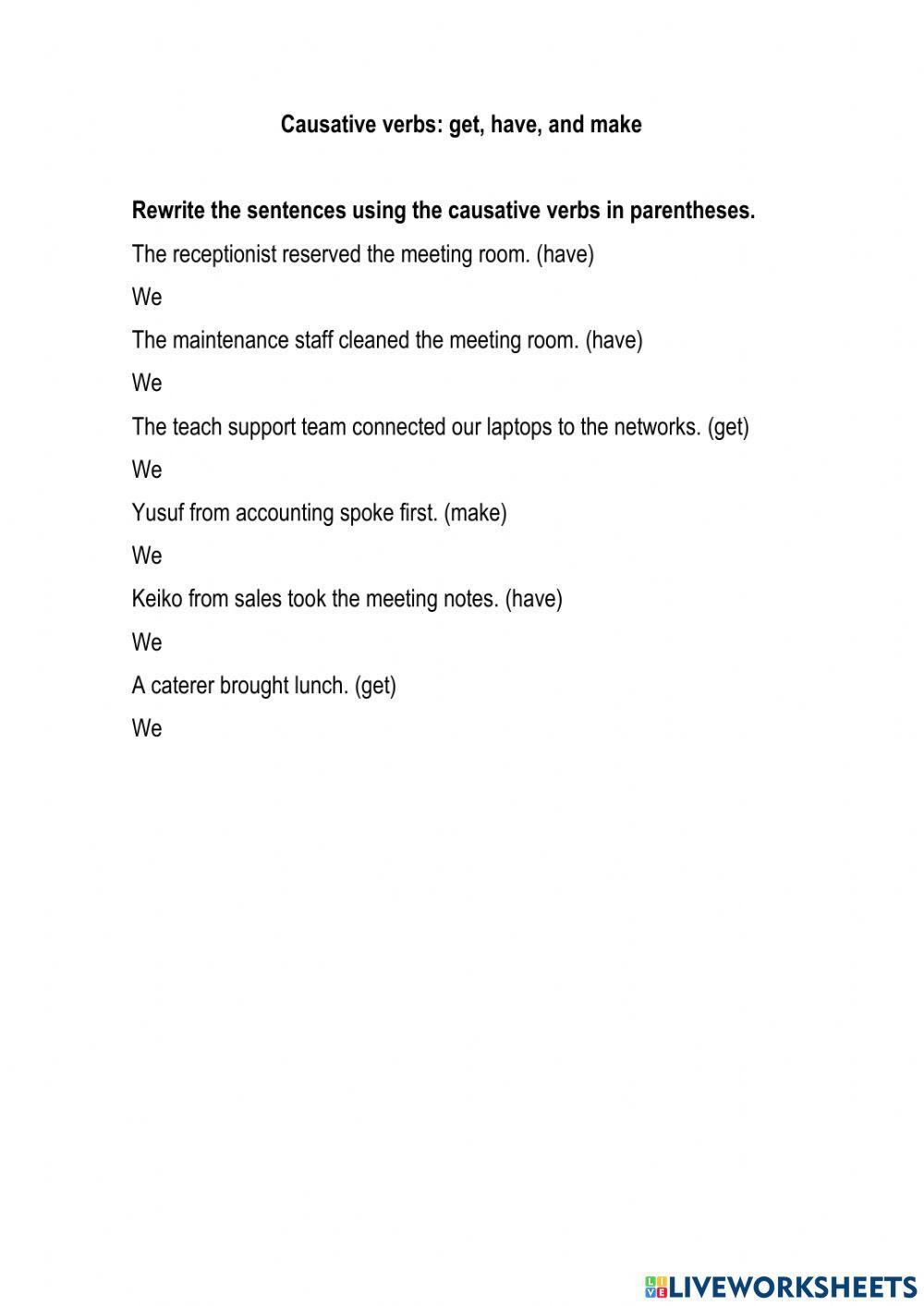
Mastering Delegation and Influence: A Comprehensive Guide to Causative Verbs Worksheets (Make, Have, Get)
In the intricate tapestry of the English language, certain grammatical structures allow us to express not just what we do, but what we cause others to do, or what we arrange to have done. These are the causative verbs, and they are indispensable for conveying nuances of delegation, persuasion, and external action. While seemingly straightforward, the correct usage of "make," "have," and "get" as causatives often poses a significant challenge for English language learners. This comprehensive guide delves into the intricacies of designing and utilizing effective Causative verbs worksheets (make, have, get), offering educators and learners a roadmap to mastering these essential linguistic tools.
The "Why" of Causative Verbs: Beyond Simple Action

At their core, causative verbs indicate that one person or thing causes another person or thing to do something, or to be in a certain state. They shift the focus from the direct actor to the instigator of the action. Understanding them is crucial for:

- Expressing Delegation: When you arrange for someone else to perform a task (e.g., "I had my car repaired.").
- Indicating Force or Compulsion: When you compel someone to do something (e.g., "My parents made me clean my room.").
- Describing Persuasion: When you convince someone to act (e.g., "I got him to help me with my project.").
- Conveying Professional Services: When you pay for a service to be done (e.g., "She had her hair cut.").



Without a firm grasp of these verbs, communication can become clunky or inaccurate. For instance, saying "I repaired my car" when you paid a mechanic to do it is grammatically correct but semantically misleading. This is where well-designed Causative verbs worksheets (make, have, get) become invaluable.
Deconstructing the Causative Trio: Make, Have, and Get

Each causative verb carries its own unique meaning, grammatical structure, and level of formality. Let’s break them down:
1. MAKE (Causative: Force/Compel)
Meaning: "Make" implies compelling or forcing someone to do something. The action is often unwilling or obligatory on the part of the person performing it.
Structure: Subject + make + Object (person) + Base Form of Verb

Examples:
- My boss made me work late. (I didn’t want to, but I had to.)
- The teacher made the students rewrite their essays. (It was an instruction they couldn’t ignore.)
- Her sad story made me cry. (The story compelled me to feel an emotion.)
- The strong coffee made him feel awake. (The coffee caused a state.)

Worksheet Ideas for "Make":
- Sentence Completion: Provide scenarios where force or compulsion is implied. "The strict coach ____ the team run extra laps."
- Transformation Exercises: Change active sentences into causative "make" sentences. "The loud music caused me to cover my ears." -> "The loud music made me cover my ears."
- Role-Play Prompts: Give students roles (e.g., parent/child, boss/employee) and scenarios where one person makes another do something.
- Error Correction: Include sentences where "make" is used incorrectly or where another causative verb would be more appropriate, challenging students to identify the error and correct it.
2. HAVE (Causative: Arrange/Request – Professional or Delegated)
Meaning: "Have" implies arranging for someone else to do something for you, often a service or a task that is part of a professional arrangement. It suggests a more collaborative or service-oriented action than "make."
Structure 1 (Active Voice – Person Performs Action): Subject + have + Object (person) + Base Form of Verb
- I had the mechanic repair my car. (I arranged for him to do it.)
- She had her assistant prepare the report. (She delegated the task.)
- We had the painter paint the living room. (We hired him for the service.)
Structure 2 (Passive Voice – Action Performed on Object): Subject + have + Object (thing) + Past Participle
This structure is very common and useful when the person performing the action is either unknown, unimportant, or obvious from context.
- I had my car repaired. (By the mechanic, implied.)
- She had her hair cut. (By a hairdresser.)
- He had his passport renewed. (By the passport office.)
- They had the house cleaned before the party. (By cleaners.)
Worksheet Ideas for "Have":
- Matching Exercise: Match situations (e.g., "Your computer is broken") with causative "have" sentences (e.g., "I need to have my computer fixed").
- Fill-in-the-Blanks (Active vs. Passive): Provide sentences and ask students to choose the correct structure of "have." "I will (the tailor / alter) my suit." vs. "I will (my suit / alter)."
- Picture Prompts: Show images of people receiving services (e.g., a person at the dentist, a car at a garage) and ask students to write sentences using "have."
- Dialogue Completion: Create short dialogues where "have" is used to discuss arrangements or services.
3. GET (Causative: Persuade/Convince; Arrange – Less Formal)
Meaning: "Get" is versatile. It can mean to persuade or convince someone to do something, implying more effort on the part of the subject than "have." It can also mean to arrange for something to be done, similar to "have," but often less formal and sometimes implying overcoming a slight obstacle.
Structure 1 (Active Voice – Person Performs Action): Subject + get + Object (person) + To-Infinitive
This is the key differentiator from "make" and "have" in the active voice.
- I got him to help me with my homework. (I convinced him.)
- She got her children to eat their vegetables. (She persuaded them.)
- How can I get my computer to work again? (How can I make it function?)
Structure 2 (Passive Voice – Action Performed on Object): Subject + get + Object (thing) + Past Participle
This structure is interchangeable with "have" in the passive voice but can imply more effort or overcoming an obstacle to get the task done. It’s often used in informal contexts.
- I got my car repaired. (Similar to "had," but might imply I had to search for a good mechanic or that it was a hassle.)
- They got their roof fixed after the storm. (They managed to arrange it.)
- He got his point across. (He successfully conveyed his message.)
Worksheet Ideas for "Get":
- Sentence Scramble: Provide jumbled words and ask students to form correct causative "get" sentences, paying attention to the "to-infinitive."
- Scenario-Based Questions: "Your friend doesn’t want to go to the party. What can you say to get him to come?"
- Compare and Contrast with "Have": Provide sentences where either "have" or "get" (passive) could be used and ask students to explain the subtle difference in meaning or formality.
- Creative Writing Prompt: Ask students to write a short paragraph about a time they had to convince someone to do something, using "get."
Comparing and Contrasting: The Nuances that Matter
A strong understanding of these differences is crucial for anyone engaging with or creating Causative verbs worksheets (make, have, get). Here’s a summary:
| Causative Verb | Core Meaning | Active Structure | Passive Structure | Formality | Implication |
|---|---|---|---|---|---|
| Make | Force/Compel | make + person + base verb |
(Not typically used causatively) | Neutral | The action is unwilling or obligatory. |
| Have | Arrange/Delegate | have + person + base verb |
have + thing + past participle |
Neutral | Professional service, planned delegation. |
| Get | Persuade/Convince; Arrange | get + person + to-infinitive |
get + thing + past participle |
Informal | Effort to convince; managed to arrange (often with effort). |
Key Grammatical Distinction: The most common error point is often the infinitive: "make" and "have" take the base form, while "get" takes the "to-infinitive" in the active causative structure.
Designing Effective Causative Verbs Worksheets (Make, Have, Get)
Creating high-quality worksheets goes beyond simply listing sentences. Here are principles for effective design:
- Clear Instructions: Always provide concise and unambiguous instructions for each exercise.
- Contextualization: Present the causative verbs within meaningful contexts (e.g., dialogues, short paragraphs, real-life scenarios) rather than isolated sentences. This helps students understand the subtle differences in usage.
- Gradual Difficulty: Start with simpler identification or fill-in-the-blank exercises and progress to more complex sentence transformations, error correction, or open-ended writing tasks.
- Variety of Exercise Types:
- Multiple Choice: Good for initial comprehension of structures.
- Fill-in-the-Blanks: Requires students to recall the correct verb and form.
- Sentence Transformation: "Rewrite the sentence using a causative verb." This is excellent for showing how meaning shifts.
- Error Correction: Present sentences with incorrect causative verb usage and ask students to identify and correct them.
- Dialogue Completion: Provide gaps in conversations that require causative verbs.
- Scenario-Based Writing: Give students a situation and ask them to write a few sentences using appropriate causative verbs (e.g., "Describe a time you had to get someone to do something they didn’t want to do.").
- Picture Prompts: Visual cues can be very effective, especially for "have/get + object + past participle" structures.
- Focus on Nuance: Include exercises that specifically highlight the differences between "make," "have," and "get" in similar contexts, forcing students to think about the underlying meaning.
- Answer Key: Provide a clear answer key for self-assessment or easy grading.
Tips for Educators and Learners Using Causative Verbs Worksheets (Make, Have, Get)
When utilizing Causative verbs worksheets (make, have, get), both educators and learners can benefit from these strategies:
- Start with the Basics: Ensure a solid understanding of each verb’s core meaning and structure before moving to comparative exercises.
- Emphasize Context: Always discuss the scenarios and implications of using one causative verb over another. Why "make" instead of "get"? What’s the difference between "I had my car repaired" and "I got my car repaired"?
- Encourage Oral Practice: After completing worksheets, have students create their own sentences orally, or engage in role-plays using the causative verbs. This solidifies understanding and improves fluency.
- Provide Constructive Feedback: Don’t just mark answers right or wrong. Explain why an answer is incorrect and guide students towards the correct choice by referring back to the rules of force, delegation, or persuasion.
- Relate to Real-World Examples: Point out causative verbs in everyday English – in news articles, movie dialogues, or advertisements. This shows their practical relevance.
- Don’t Overwhelm: Introduce one causative verb at a time, or compare just two, before tackling all three together.
- Review Regularly: Like any complex grammatical structure, causative verbs require periodic review to ensure long-term retention.
Conclusion
Causative verbs are more than just grammatical curiosities; they are powerful tools that allow for precise and nuanced communication in English. While challenging, mastering "make," "have," and "get" opens up new avenues of expression for learners. By embracing the power of well-crafted Causative verbs worksheets (make, have, get), learners can confidently navigate the complexities of delegation, influence, and arranged actions, transforming abstract rules into practical, usable language skills. With thoughtful design and diligent practice, these worksheets can be the cornerstone of a truly effective learning experience.

